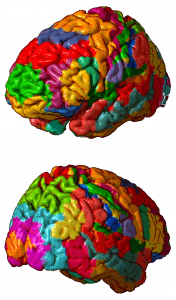The Case for Case Studies
TAPP Radio Episode 52
Quick Take
Host Kevin Patton discusses the many ways case studies can be used in teaching, why they enhance learning, and where to find them. Also, updates in factors underlying left-handedness, functional maps of the brain, and reversing biological age, plus some tips on responding to student questions.
00:44 | Left-handedness
02:54 | Responding to Students
22:30 | Sponsored by HAPS
22:59 | Mapping Brain Functions
26:55 | Sponsored by AAA
27:14 | Reversing Age
30:32 | Sponsored by HAPI Online Graduate Program
31:18 | Case Studies in Teaching A&P
47:59 | Staying Connected
Listen Now!
Get the full experience—listen to this episode’s Preview first (with additional content).
If the left half of the brain controls the right half of the body then only left handed people are in their right mind. (W.C. Fields)
1 | Left-Handedness
A new report suggests that left-handedness, which one in ten of us exhibit, is partially influenced by genes. One effect of these genes is to change the structure of our body cells’ cytoskeleton. Of course, a lot more work has to be done. By left-handers and right-handers alike.
- Left-handed DNA found – and it changes brain structure (brief summary article) my-ap.us/2AfTLAQ
- Handedness, language areas and neuropsychiatric diseases: insights from brain imaging and genetics (research article) my-ap.us/2AbWACQ
2 | Responding to Students
Half of students don’t read the syllabus, don’t read directions, don’t listen to us—which can produce some frustrations when they reach out to us with questions that they already have the answer for. Somewhere nearby them. Kevin gives some tips on how to to handle these with grace and ease (taking barely any time or effort), as well as advice on heading them off before they are asked.
- The Syllabus Episode | Bonus | Episode 24
- Connecting in The Distance Course Special | Episode 50
- TextExpander (software to cut and paste automatically) theapprofessor.org/textexpander
- Google forms (software to make inquiry forms for students that require them to give specifics about their question) my-ap.us/2AfzbQU
3 | Sponsored by HAPS
0.5 minutes
 The Human Anatomy & Physiology Society (HAPS) is a sponsor of this podcast. You can help appreciate their support by clicking the link below and checking out the many resources and benefits found there. There are a bunch of 1-day regional workshops scattered all over the continent. There’s probably one near you coming up this year (or next)!
The Human Anatomy & Physiology Society (HAPS) is a sponsor of this podcast. You can help appreciate their support by clicking the link below and checking out the many resources and benefits found there. There are a bunch of 1-day regional workshops scattered all over the continent. There’s probably one near you coming up this year (or next)!
4 | Mapping Brain Functions
4 minutes
We’ve all see various functional maps of the human brain. But once you get down to the smaller regions, or parcels, it gets weird. Beyond a certain resolution, things are very flexible. Because functions of tiny parcels vary with the state of that region of the brain in any given moment, we will probably not be able to produce a high-resolution functional map of the brain—even for any one individual.
- There is no single functional atlas even for a single individual: Parcellation of the human brain is state dependent (research article) my-ap.us/2Aighc0
- Brodmann areas (maps and explanation) my-ap.us/2Qc2COA
5 | Sponsored by AAA
0.5 minutes
- A searchable transcript for this episode, as well as the captioned audiogram of this episode, are sponsored by the American Association for Anatomy (AAA) at anatomy.org.
6 | Reversing Age
3.5 minutes
Can biological age be reversed? Some research in a small group of older men suggest it may be possible. Using a cocktail of common drugs, their epigenomes showed a younger biological age. Hmm.
- First hint that body’s ‘biological age’ can be reversed (brief summary from Nature) my-ap.us/2Ad78BR
- Reversal of epigenetic aging and immunosenescent trends in humans (research article from Aging Cell) my-ap.us/2AfUmCA
7 | Sponsored by HAPI Online Graduate Program
1 minute
 The Master of Science in Human Anatomy & Physiology Instruction—the MS-HAPI—is a graduate program for A&P teachers. A combination of science courses (enough to qualify you to teach at the college level) and courses in contemporary instructional practice, this program helps you power up your teaching. Kevin Patton is a faculty member in this program. Check it out!
The Master of Science in Human Anatomy & Physiology Instruction—the MS-HAPI—is a graduate program for A&P teachers. A combination of science courses (enough to qualify you to teach at the college level) and courses in contemporary instructional practice, this program helps you power up your teaching. Kevin Patton is a faculty member in this program. Check it out!
8 | Case Studies in Teaching Anatomy & Physiology
In this discussion, Kevin defines what a case study is, described some different sorts of case studies, explains why case studies are such a powerful learning experience, and give sources for peer-reviewed, classroom-tested case studies for A&P. And a few odd and creative ideas, one from listener Christy Pitts, thrown in as a bonus! We’re all about bonuses here.
- Bloom’s taxonomy my-ap.us/2ZWfLjt
- Fink’s taxonomy of significant learning my-ap.us/2Q4IQEN
- National Center for Case Study Teaching in Science my-ap.us/ScienceCases
- Grumpy Old Man: Hypercalcemia and the Parathyroid Gland (this case study & others by Sheri L. Boyce) my-ap.us/2ZUWAq3
Life Science Teaching Resource Community my-ap.us/LifeSciTRC[Note: this resources is no longer available]
Need help accessing resources locked behind a paywall?
Check out this advice from Episode 32 to get what you need!
(If no link or player are visible, go to https://youtu.be/JU_l76JGwVw?t=440)
This podcast is sponsored by the
Human Anatomy & Physiology Society

This podcast is sponsored by the
Master of Science in
Human Anatomy & Physiology Instruction

Stay Connected
The easiest way to keep up with new episodes is with the free mobile app:


Or you can listen in your favorite podcast or radio app.
Click here to be notified by blog post when new episodes become available (make sure The A&P Professor option is checked).
Transcript
To read a complete transcript of this episode,
click here.
The searchable transcript for this episode is sponsored by
The American Association for Anatomy.
Call in
Record your question or share an idea and I may use it in a future podcast!
Toll-free:
1·833·LION·DEN
(1·833·546·6336)
Local:
1·636·486·4185
Email:
podcast@theAPprofessor.org
Share

Preview of Episode 53
A brief preview of the upcoming full episode 53, featuring upcoming topics that include tips for amplifying learning in the A&P course, updates regarding the role of exosomes in the spread of cancer and how heart shape relates to human activity. There’s more… some word dissections and Kevin’s recommendation for The A&P Professor Book Club.
Topics
1 minute
- Strategies to amplify learning in the A&P course
- The role of exosomes in the spread of cancer
- How heart shape relates to type of activity
Word Dissections
8.5 minutes
- Metastasis
- Extracellular vesicle (EV)
- Exosome
- Oncosome
- Transcytosis
Book Club
3.5 minutes
- Prime Mover: A Natural History of Muscle
- by Steve Vogel
- amzn.to/30jcKcm
- Special opportunity
- Contribute YOUR book recommendation for A&P teachers!
- First five submitted and used will be in a drawing for a Kindle Fire HD 10 tablet
- Any contribution used will receive a $25 gift certificate
- The best contribution is one that you have recorded in your own voice (or in a voicemail at 1-833-LION-DEN)
- Check out The A&P Professor Book Club
Last updated: February 2, 2024 at 15:02 pm











